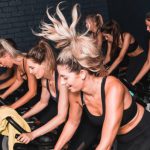Tip # 1: Transition
Increasing the speed you transition from one move to another is the best way to up the intensity. Yes, transitions are a sneaky way to get some rest, but in the Lagree method we don’t rest so we can work each muscle group to failure. (The fastest way to change your body!)
Listen carefully to your instructor's cues: she/he will name the next exercise or movement. Listen for the body position and spring load, then when they say go, make haste and move quickly. If you are new, follow an experienced participant for the most efficient way to get into the new position.
Tip # 2: Tempo
In the Lagree method, we use the slow cooker method to tone and strengthen our legs, arms and abs. The common mistake most people make is moving too fast on the Megaformer.
Each movement should take about 8 seconds to complete. For example, in Elevator Lunge we take 4 seconds to descend and then 4 seconds to rise. Always think slow and smooth, while resisting the hesitation to speed up once the burn starts. Burning means it's working!
Tip # 3: Spring Load
In lower body exercises where we push the carriage, such as Skating or Spider Lunge, we usually start our new clients off on 1 red spring. If you are pushing the carriage and it feels too light simply add 1 or 2 yellow springs to increase the intensity.
In lower body exercises where we pull the carriage, such as Escalator Lunge, start on a couple of yellow springs. In these exercises the springs are actually helping you, so take springs off to make the workout harder.
Tip # 4: Lever
This technique applies to all exercise in general. Using our arms or legs to make our body (the lever) longer will cause your muscles to work harder. Conversely, reducing the lever length by bringing your arms or legs closer towards your body will reduce the intensity.
For example, In a Tower Twist (an oblique exercise) when our arms are close to our chest the movement is easier. To make this movement harder, simply extend you arms out from your chest.
Other examples:
- Super Crunch: arms crossed over chest is easier, arms extended over head is harder.
- Seated Row: elbows close to the sides of the body, moving forward and back in line with shoulders is easier, arms out wide like hugging a barrel is harder.
Tip # 5: Stability
My last tip…and this one is probably our favourite…it’s time to fly! Many movements can be made into a flying exercise. When a movement is ‘flying’ you reduce your stability (base of support) causing your core to engage more.
The Mega Donkey Kick primarily focuses on the moving leg. However, if we raise the opposite knee from the carriage our core engagement increases and so does the intensity. Next time your instructor cues Donkey Kicks, Spider Kicks, Push-ups or Scrambled Eggs, why not push yourself and fly?
See you soon,
Ash
Post By
Ash Dean
Certified Personal Trainer with 10 years experience. Certified Lagree Fitness Instructor teaching at LaFit Studio, Perth WA. Currently studying Exercise Science at Edith Cowan University.
You can join Ash at LaFit Studio on Mondays, Wednesdays and Fridays.


